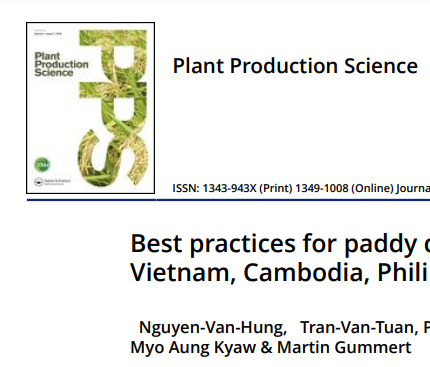Best practices for paddy drying: case studies in Vietnam, Cambodia, Philippines, and Myanmar guyen-Van-Hung, Tran-Van-Tuan, Pyseth Meas, Caesar Joventino M. Tado, Myo Aung Kyaw & Martin Gummert To cite this article: Nguyen-Van-Hung, Tran-Van-Tuan, Pyseth Meas, Caesar Joventino M. Tado, Myo Aung Kyaw & Martin Gummert (2018): Best practices for paddy drying: case studies in Vietnam, Cambodia, Philippines, and Myanmar, Plant Production Science, DOI: 10.1080/1343943X.2018.1543547 To link to this article: https://doi.org/10.1080/1343943X.2018.1543547 ARTICLE HISTORY Received 16.
-----------------------------------------------------------------------------------------------------------------------------------------
Best practices for paddy drying: case studies in Vietnam, Cambodia, Philippines, and Myanmar
guyen-Van-Hung, Tran-Van-Tuan, Pyseth Meas, Caesar Joventino M. Tado, Myo Aung Kyaw & Martin Gummert
To cite this article: Nguyen-Van-Hung, Tran-Van-Tuan, Pyseth Meas, Caesar Joventino M. Tado, Myo Aung Kyaw & Martin Gummert (2018): Best practices for paddy drying: case studies in Vietnam, Cambodia, Philippines, and Myanmar, Plant Production Science, DOI: 10.1080/1343943X.2018.1543547 To link to this article: https://doi.org/10.1080/1343943X.2018.1543547
ARTICLE HISTORY
Received 16 June 2018
Revised 13 October 2018
Accepted 26 October 2018
Plant Production Science
ISSN: 1343-943X (Print) 1349-1008 (Online) Journal homepage: http://www.tandfonline.com/loi/tpps20
-----------------------------------------------------------------------------------------------------------------------------------------
ABSTRACT
Our study made a comparative analysis of the different drying practices used in Vietnam,Cambodia, the Philippines, and Myanmar. Quantification of energy efficiency, greenhouse gas (GHG) emissions, and cost-benefits generated the implications for selecting the optimal drying practice corresponding to various techno-economic indicators, environments, scales of operations, and market demands. Using are versible airflow flatbed dryer with a capacity of 20 tons of paddy per batch was found to be the best option in terms of cost-benefit, labor operation, and energy efficiency. On the other hand, a recirculating columnar dryer requires 15% higher energy consumption but only needs 20–50% of the floor area; while a solar bubble dryer still needs optimization interms of reduced investment cost and labor requirement. A two-stage drying system including a fluidized-bed and ten recirculating columnar dryers is an optimal option with the lowest drying cost and labor use when aiming at an industrial capacity of greater than 200 t/day. Nevertheless, the energy consumption and GHG emission of the solar bubble dryer are lower by more than 50% than that of other practices. In addition to the comparative analysis of these techno-economic factors, this research also identified the trajectories of developing paddy drying technologies that are aligned with different postharvest systems identified as subsistence farming for own consumption, surplus farming for local markets, and surplus farming for premium and export markets. The study recommends paddy drying strate- gies in Southeast Asian countries that could be applied in other rice-production regions as well.
Abbreviation: GHG: greenhouse gas
KEYWORDS Rice; postharvest; drying; best practices; life-cycle assessment
Số lần xem trang: 3723


